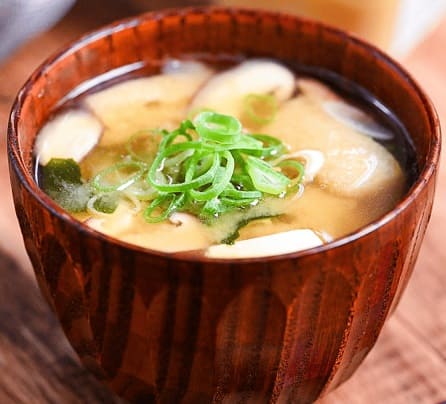Recipe | Picture | Ratings | Link |
Egg Drop Soup | |||
Spicy Chicken and Corn Soup |
Miso Soup (Japan)
Miso soup is a traditional Japanese dish that is both comforting and nourishing. It has been a staple in Japanese cuisine for centuries and is known for its umami flavor, which comes from the fermented soybean paste called miso.
This soup is not only delicious but also offers a wealth of nutritional benefits. It can be enjoyed on its own or as a part of a larger meal. The beauty of miso soup lies in its versatility; you can customize it with various ingredients according to your taste and seasonal availability.
This recipe will guide you through the steps to create a classic miso soup, making it easy to replicate this favorite at home.
Ingredients
- 4 cups dashi stock (you can use instant dashi powder or make your own from kombu and bonito flakes)
- 3 tablespoons miso paste (white or yellow miso is recommended for a milder flavor)
- 1/2 cup tofu (firm or silken, cut into small cubes)
- 1/4 cup green onions (scallions, thinly sliced)
- 1/2 cup seaweed (wakame, rehydrated if dried)
- 1/2 cup mushrooms (shiitake or enoki, sliced)
- 1 small carrot (thinly sliced or julienned)
- Optional: Additional vegetables like bok choy, spinach, or radish
- Soy sauce (to taste)
- Sesame oil (a drizzle for added flavor, optional)
How to Make
Prepare the Dashi Stock:
If using instant dashi powder, dissolve the recommended amount in 4 cups of water according to package instructions. If making your own dashi, soak a piece of kombu (dried kelp) in cold water for at least 30 minutes, then bring it to a gentle simmer. After about 10 minutes, remove the kombu and add bonito flakes. Allow it to simmer for another 5 minutes, then strain the stock to remove the flakes.
Cook the Vegetables:
In a pot, bring the dashi stock to a gentle simmer over medium heat. Add the sliced mushrooms and carrots to the pot. Cook for about 5 minutes until the vegetables are tender.
Add the Tofu and Seaweed:
Gently add the tofu cubes and rehydrated wakame to the pot. Simmer for an additional 2-3 minutes to heat the tofu through and allow the seaweed to expand and soften.
Incorporate the Miso:
In a small bowl, ladle out about 1 cup of the hot dashi stock. Add the miso paste to the bowl and whisk until smooth. This helps to dissolve the miso evenly without clumps. Pour the miso mixture back into the pot and stir well. Be careful not to boil the soup after adding miso, as high heat can destroy its beneficial properties.
Recipe | Picture | Ratings | Link |
Shrimp Bisque | |||
Chicken Tortilla Soup |
Final Touches:
Taste the soup and adjust seasoning with a splash of soy sauce if desired. Add sliced green onions just before serving for freshness and color. If using sesame oil, drizzle a small amount on top for added richness.
Serve:
Ladle the miso soup into bowls and serve immediately. It pairs wonderfully with rice, pickled vegetables, or sushi.
Chef’s Note
Choosing Miso: There are various types of miso, including white, yellow, red, and black. White miso is milder and sweeter, making it an excellent choice for beginners. Red miso has a stronger flavor and is often used in heartier soups. Experiment with different types to find your preferred taste.
Adding Protein: For a more filling soup, consider adding proteins such as shrimp, clams, or chicken. Just ensure they are cooked through before adding them to the soup.
Vegetable Variations: The beauty of miso soup lies in its adaptability. Feel free to incorporate seasonal vegetables, or use whatever you have on hand. Leafy greens, daikon radish, or even corn can add delightful flavors and textures.
Nutritional Information (per serving, approx. 1 cup)
- Calories: 70
- Protein: 5g
- Fat: 3g
- Carbohydrates: 7g
- Fiber: 1g
- Sodium: 800mg (varies based on dashi and soy sauce used)
- Calcium: 60mg
- Iron: 1mg
Miso soup is rich in probiotics, thanks to the fermentation of the miso paste. It is also a good source of vitamins and minerals, particularly when loaded with vegetables. The tofu provides a plant-based protein source, making this soup suitable for vegetarians and vegans.
Conclusion
Miso soup is more than just a dish; it embodies the essence of Japanese culinary philosophy—balancing flavors, textures, and nutrition in a single bowl.
Whether enjoyed as a comforting bowl on a chilly evening or as part of a larger feast, it is a dish that nurtures the body and soul. So gather your ingredients, follow the steps, and experience the warm, umami-rich flavors of homemade miso soup!
Thanks for visiting Soups Recipe
Recipe | Picture | Ratings | Link |
Carrot Ginger Soup | |||
Chicken Noodle Soup | |||
Italian Sausage Soup | |||
Sopa de Mariscos |

